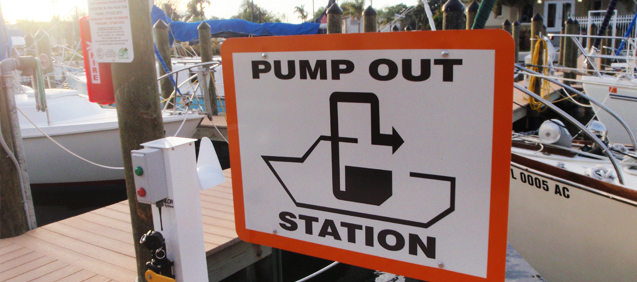Sewage Pumpout Facilities

Description
Providing sewage pumpout facilities at marinas significantly reduces the harmful effects of directly discharging sewage from boats into the water, either from portable toilets or from holding tanks. There are three types of pumpout facilities, described in "design considerations" below.
Applicability
This practice is applicable to all marinas, regardless of whether they are frequented by small boats with portable toilets or large boats with holding tanks.
Effectiveness
Two of the most important factors in successfully preventing sewage discharge from boats are providing adequate and reasonably available pumpout facilities and conducting a comprehensive boater education program. Designation and advertisement of no-discharge zones can also increase boater use of pumpout facilities (MDDNR, 1991). Marina operators should post ample signs prohibiting the discharge of sanitary waste from boats into the waters of the State, including the marina basin, and also explaining the availability of pumpout services and public restroom facilities. An example of a sign designed for this purpose is shown to the right.
Costs
Costs associated with pumpouts vary according to the size of the marina and the type of pumpout system (see design considerations). Cost estimates below are for capital costs and do not include labor (CZM 2001).
| BMP | Cost | Funding Sources |
| Pumpout Maintenance | $1-$100 | Fees, State Funding |
| Pumpout Cleanliness | $1-$100 | No Extra Cost |
| Pumpout Staffing and Training | >$1000 | Fees, State Funding |
| Low Pump-out Costs | $1-$100 | No Extra Cost |
| Pumpout Signs | $1-$100 | State Funding |
| Holding Tank Additives | $1-$100 | Sales at Ship Store |
| Portable Dump Stations | $100-$1,000 | State Funding |
| Prohibit Sewage Discharge | $1-$100 | No Extra Cost |
| Fill Disinfectant Tanks | $1-$100 | No Extra Cost |
| Shoreside Facilities | >$1000 | Capital Expenditure |
| Biodegradable Holding Tank Cleaners | $1-$100 | Sales at Store |
| Discharge Prevention Steps | $1-$100 | No Extra Cost |
| Customer Education | $1-$100 | Free Cash |
| MSD Retrofit Services | $100-$1,000 | Service Charge |
| Low Nitrogen Detergents | $1-$100 | Sales at Store |
| Encourage Use of Marina Facilities | $1-$100 | No Extra Cost |
The number of facilities required may range from 200 for small marinas to 2000 for larger ones (USEPA). The cost of dye tablets for detecting improper discharge is approximately $30 per 200 tablets. See the Clean Vessel Act Pumpout Grant Program website (USFWS 1999) for additional funding information.
Maintenance
To prevent the failure of pumpout stations and improper disposal of sanitary wastes, maintenance procedures include:
- Arranging maintenance contracts with contractors competent in the repair and servicing of pumpout facilities.
- Developing regular inspection schedules.
- Maintaining a dedicated fund for the repair and maintenance of marina pumpout stations (Government-owned facilities only).
- Adding language to slip leasing agreements mandating the use of pumpout facilities and specifying penalties for failure to comply.
- Placing dye tablets in holding tanks to discourage illegal disposal.
Design Considerations
There are three main types of sewage pumpout facilities:
1. Fixed-point collection systems include one or more centrally located sewage pumpout stations generally located at the end of a fueling pier so that fueling and pumpout operations can be combined. A flexible hose is connected to the wastewater fitting in the hull of the boat, and the pump moves the wastewater to an onshore holding tank, a public sewer system, a private treatment facility, or another approved disposal facility. If boats in the marina use small portable (removable) toilets, a satisfactory disposal facility could be a dump station.
2. Portable/mobile systems are similar to fixed-point systems and in some situations may be used in their place at a fueling dock. The portable unit includes a pump and a small storage tank. The unit is connected to the deck fitting on the vessel, and wastewater is pumped from the vessel’s holding tank to the pumping unit’s storage tank. When the storage tank is full, its contents are discharged into a municipal sewage system or a holding tank for removal by a septic tank pumpout service.
3. Dedicated slipside systems provide continuous wastewater collection at a slip. Slipside pumpout should be provided to live-aboard vessels. The remainder of the marina can still be served by either marina-wide or mobile pumpout systems.
References
MDDNR. 1991. A Guidebook for Marina Owners and Operators on the Installation and Operation of Sewage Pumpout Stations. Maryland Department of Natural Resources, Boating Administration, Annapolis, MD.
Natchez, D.S. 1991. Are Marinas Really Polluting? International Marina Institute, Wickford, RI. USEPA. National Management Measures for Controlling Nonpoint Source Pollution from Marinas and Recreational Boating. EPA 841-B-01-005. United States Environmental Protection Agency,
http://www.epa.gov/owow/nps/mmsp/
USEPA. 1985. Coastal Marinas Assessment Handbook. U.S. Environmental Protection Agency, Region 4, Atlanta, GA. April.
USEPA. 2002. Vessel Boating Discharge Program. US Environmental Protection Agency, Office of Water, Oceans and Coastal Protection Division. Accessed 5/7/02.
http://www.epa.gov/owow/oceans/regulatory/vessel_sewage/
Recommended Fact Sheets and Resources
CZM. 2001. Massachusetts Clean Marina Guide. Prepared by Epsilon Associates, Inc. for the Massachusetts Department of Coastal Zone Management,
http://www.state.ma.us/czm/marinas/guide/macleanmarinaguide.htm
CZM. 2002. Massachusetts Pumpout Facilities. Massachusetts Office of Coastal Zone Management. Accessed 8/2/02.
http://www.state.ma.us/czm/potoc.htm
USEPA. 1996. Clean Marinas Clear Value; Environmental and Business Success Stories. EPA 841-R-96-003.
http://www.epa.gov/owow/nps/marinas/index.html
USFWS. 1999. Clean Vessel Act Pumpout Grant Program. U.S. Fish and Wildlife Service, Division of Federal Aid. Accessed 7/15/02.
http://federalasst.fws.gov/cva/cva.html
VDEP. 2001. The Virginia Clean Marina Guidebook. Virginia Department of Environmental Quality, Virginia Department of Conservation and Recreation, Richmond, Virginia.
http://www.vims.edu/adv/cleanmarina/guidebook.html